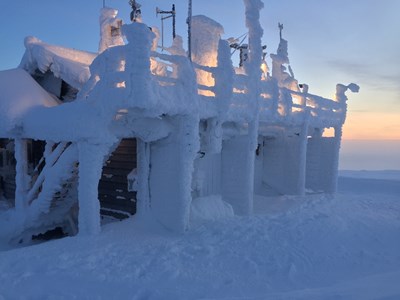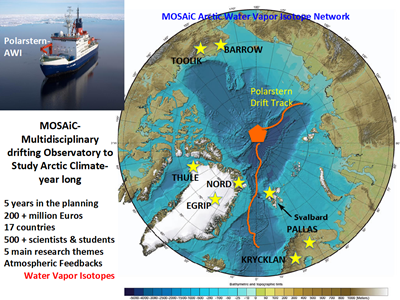His 7-nation, network of water vapor and precipitation isotope monitoring and measuring stations in Alaska (Barrow and Toolik), Greenland (Thule & Nord), Sweden (Krycklan), Finland (Pallas), Svalbard-Norway (NyAlesund) and aboard the in German Polarstern Icebreaker will operate simultaneously 12+ months. This first of it’s kind network, will track in real time water vapor and precipitation sources and transport within, out of and into the Arctic beginning this summer and throughout the Polar Night of winter 2019-2020 and through the spring and summer of 2020.
This MOSAiC Arctic Water Cycle study is funded by the US NSF Arctic Observing Network, Academy of Finland, an Arctic 5 collaboration between University of Oulu and University of Tromsø, and in-kind support by Germany, Denmark, Sweden and Norway.
MOSAiC, Multidisciplinary drifting Observatory for the Study of Arctic Climate, has been 5 years in the planning and is being lead by the Alfred Wegener Institute (AWI) and will be centered in large part on the AWI Polarstern Icebreaker that will be frozen into the Eurasian Arctic in October and drift across the N Pole and down through the Fram Straight and into the Barents Sea next summer (See Map). The Polarstern will house up to 100 scientists at a time, supporting ice camps, coordinating underwater UAV’s, sea ice camps and marine ecosystem process studies.
The primary goal of MOSAiC is to develop a better understanding of the coupling of atmospheric processes, sea ice properties, Arctic Ocean biogeochemistry, and marine processes. Understanding these interactions in the eastern Arctic Basin will be used to resolve how sea ice changes are altering the function and structure of the Arctic region. This transformational understanding will allow regional and global-scale models to more accurately predict global climates and weather of the future and completely alter the ability to predict sea-ice changes and it’s consequences in the future.

MOSAiC station in Arctic Finland, Sammaltunturi at Pallas National Park. UOulu and the Finnish Meteorological Institute are collaborating to house and operate our Picarro devices that continuously measure the δ18O and δ 2H values of water vapor. This real-time data will then be integrated into a web-based visualization display which hind-cases water vapor moisture sources. In Arctic Finland, precipitation sources typically flip back and forth from the Barents Sea to the North or the North Atlantic to the south and west.

Map of the MOSAiC Arctic Water Vapor Isotope Network and the Polarstern ice-locked drift pattern from the Eastern Arctic, across the N Pole and through the Fram Straight into the Barents Sea region.
Participating Team members include:
Finland-Drs. B Klove, H Bailey, K Mustonen, H Marttila, P Ala-Aho, A Lipponen & T Vihma
USA-Drs. E Klein, D Noone, M Shupe, B Kopeck & P Akers
Sweden-Drs. N Hasselquist & N Kozii
Norway-Drs. A Hubbard, R Krejci, C Pedersen, D Divine & H Steen-Larsen
Germany-Dr. M Werner
Denmark-Dr. H Skov
